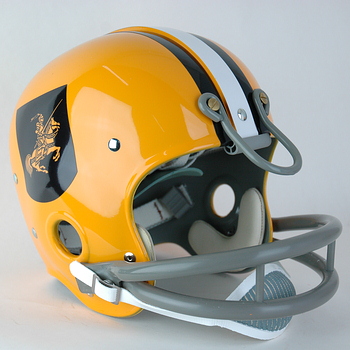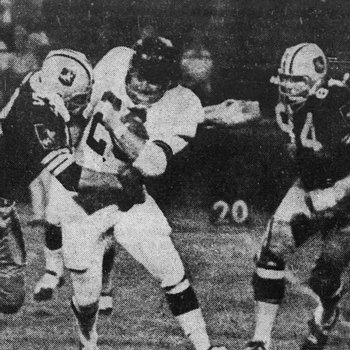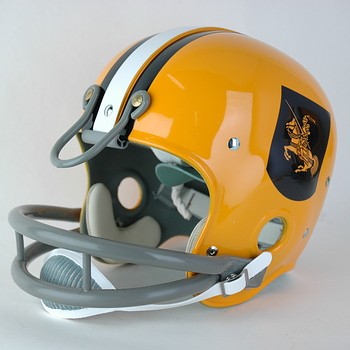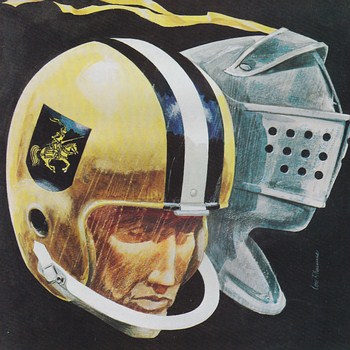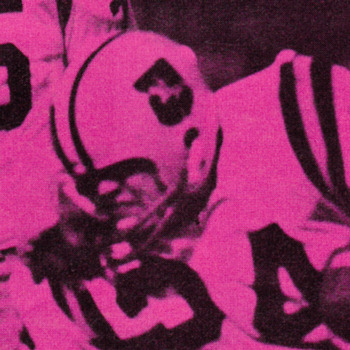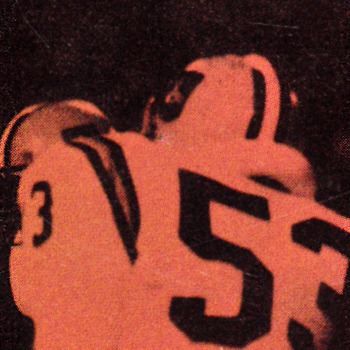
Hartford
Knights
(Authentic Reproduction)
There was a day and age when minor league football served a
place on the American sports scene. Some were provided limited
financial support or had a working arrangement with existing
National Football or American Football League teams while others
remained very much on their own. All of the teams in a number of
different leagues provided one more opportunity for aspiring pro
players, over-the-hill-pro players, and former college or high
school players to earn another opportunity for their vision of
gridiron glory. Some of the leagues and teams were well funded,
others less so as evidenced by a short, tumultuous existence. In
all cases, the players were earnest in their attempts to play
because the overwhelming majority would not and never did earn a
real living at the endeavor.
HELMET HUT
has featured a number of articles noting the minor leagues of
the 1960s [ see Helmet News/Reflections: Aug 2007, Aug 2010,
June 2013, Sept 2013 ] but those who lived during the era
understood that the Continental Football League and Atlantic
Coast Football League among others served a valuable purpose.
Some AFL and NFL teams utilized their minor league affiliates to
allow injured personnel to “play their way back into condition”
before returning them to their active rosters. Every minor
league player recalls one or two teammates or opponents who were
better than a highly drafted star but released from the parent
pro club in favor of the bigger name athlete. In some cases the
discarded player returned to earn an NFL or AFL living for a
number of years. In all cases, minor league players participated
for their love of the game, the camaraderie of teammates, and
not the paltry money paid to them.
The two prominent Minor Leagues during the 1960s were the
Continental and the Atlantic Coast Football Leagues. All of the
minor leagues had changing and shifting franchises but the two
noted presented a very high level of football and numerous
players with true professional talent. Despite franchise
re-births and moves augmented by interleague competition for
players, a few squads were able to stand out and remain
consistent contenders. One of the outstanding teams in the ACFL
was the Hartford Knights. Hartford fielded an ACFL team, the
Charter Oaks, as early as 1964 but they jumped to the newly
formed Continental League for the ’65 season and were out of
business after 1967. The Hartford Knights were established by
brothers Herb and Marvin “Pete” Savin, local construction
industry business owners, where they found immediate success in
’68 and established a working relationship with the NFL Green
Bay Packers. Under the leadership of head coach Fred Wallner who
piloted the squad through 1971, they were among the most
successful teams in the history of minor league football,
finishing their inaugural season at 11-1 and capturing the ACFL
championship. Wallner was a former All American at Notre Dame
who had played as an All Pro for the NFL Cardinals and then the
Houston Oilers in their first season, serving the AFL entry as a
player-coach after it was determined he was better than the
offensive linemen the team had brought to camp. He was an
assistant at Marquette and Tulane before taking the Charter Oaks
head job and moved to the N.Y. Jets minor league affiliate in
Waterbury, CT before returning to Hartford for the 1968 season.
With the financial backing of the Savins and decent crowds at
Hartford’s Dillon Stadium, the squad proved their mettle,
winning the ACFL title in 1968, entering the ’69 season and
running their win streak to twenty consecutive games until
dropping the season’s final two contests and the championship
game to the Pottstown, PA. Firebirds, the Philadelphia Eagles
affiliate.
1970 again matched Pottstown and their well-known quarterback
Jim “King” Corcoran against the Knights in what became known as
the “Snow Bowl” championship game played on December 17. The
Knights once more were on the short end of the 31-0 final score.
The league barely survived the 1971 season which would be Head
Coach Wallner’s last. The four team contingent played a
round-robin schedule that left Hartford and the Norfolk Neptunes,
a reincarnation of the Pottstown team that had merged with the
Virginia squad playing in yet another championship match-up that
found the Knights once more on the wrong side of the game
ledger. The league was forced to suspend operations for the 1972
season but the Knights remained viable under the leadership of
Head Coach Nick Cutro, a veteran of minor league coaching
positions. They dominated the lower level Seaboard League,
returning to a final, last gasp ACFL season in 1973. The passing
of both the Continental and Atlantic Coast Football Leagues left
a void in opportunity for those who wished to watch football,
play football, and enjoy football. The minor leagues and teams
like the Hartford Knights served a very positive and enjoyable
purpose.
Giving credit to the Savins for willingly losing money while
attempting to operate a well-run and “first class” operation,
the Knights were financially limited after 1969 when NFL
Commissioner Pete Rozelle banned NFL affiliation with minor
league teams, believing that those without it were at a
competitive disadvantage. The Hartford entry had shifted their
professional affiliation from the Packers to the Buffalo Bills
and losing financial support truly crippled minor league
football. Still, the Knights were always well attired in the
most modern of equipment and presented well in their black and
gold uniforms topped by a Green Bay gold helmet with a white
center stripe and black flanking stripes. What became Hartford’s
signature Black Knight decal as its official logo was not
introduced as their helmet decal until the ’69 season. The
original decal on the their game helmets featured a gold Knight
on horseback with black highlights but it was understandable
that it took some time to reorganize a minor league team in
Hartford. Interestingly, Marv Hubbard who had first failed to
make the Oakland Raiders active squad in ’68 and instead spent
the season with Hartford as the circuit’s leading rusher with
899 yards and a 5.6 yards per carry average, stated that he
recalled early references and printed advertising material
noting the ’68 Hartford entry as “the Charter Oaks.” Everyone
who recalls minor league football and the Hartford Knights also
recalls the easy to visualize black shield image that served as
the team’s official logo, one that represented true royalty in
minor league football history.
[Author’s
Note: for a complete and entertaining history of the Knights and
Minor League Football in Connecticut, read Connecticut Gridiron
by author William Ryczek]


